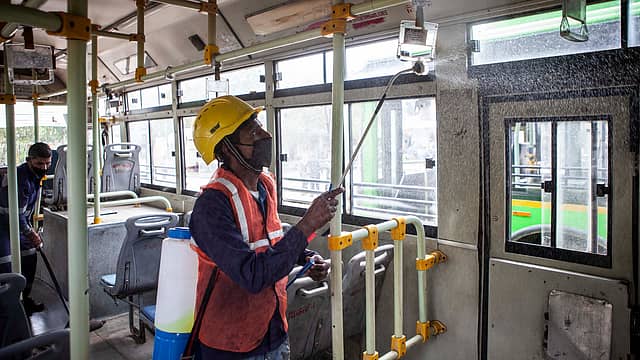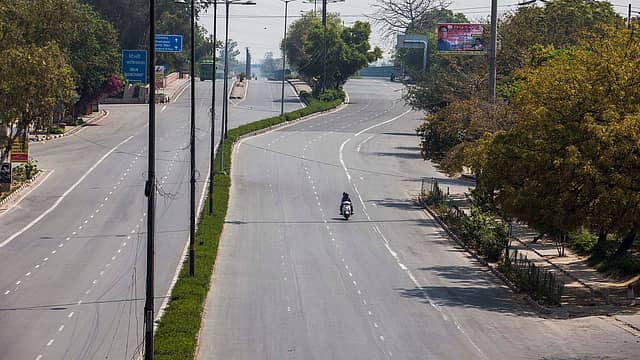Can Modi tame the black swan?
ADVERTISEMENT

“There are decades when nothing happens and there are weeks when decades happen.” When leftist leader Vladimir Ilyich Ulyanov, or Lenin, made this statement nearly a century ago, his context was the political and social revolution that would change Russia forever. Apply the same sentiment to the last few weeks in 2020, and it will ring as true.
ONLY, THIS TIME, the social and economic unrest is being wrought by a virus that has shut down the world, giving policymakers and central bankers their biggest struggle to save their own countries, and the world, from slipping into the deepest recession since the Second World War. The novel Coronavirus, or Covid-19, that originated late last year in Wuhan, the sprawling capital of Central China’s Hubei province, has spread across the globe, becoming a pandemic (as announced by the World Health Organization, or WHO) that threatens to bring the world to its knees. The outbreak, without a cure or even a vaccine, has spared none, neither the poor and underdeveloped nor the rich and advanced nations.
The rarity of its occurrence and the unpredictability of its impact, or even of how it will unravel, is the reason why it fits the definition of a Black Swan event, a concept popularised by mathematician and former Wall Street investor Nassim Nicholas Taleb in his book Black Swan. (It was released in 2007, months before the financial crisis erupted.) Though there are those chary of letting the label stick (including Taleb himself), the fact is, as Suresh Narayanan, chairman and managing director, Nestlé India, puts it: “What we are witnessing is a public health emergency far graver than anything that, as a society, we have ever been through.’’ According to Bengaluru-based serial entrepreneur K. Ganesh, who is a partner at GrowthStory (which has promoted brands such as bigbasket, Portea, and HungerBox), “it is a global pandemic of an unprecedented scale. It is the toughest challenge for the global economy”
In India, for the Narendra Modiled Bharatiya Janata Party government that is just completing the first year of its second five-year term, the pandemic has struck at an already critical juncture. Even the finance ministry’s own publication, the Economic Survey 2019-20, had said that the “dark clouds hovering over the Indian economy are unlikely to go away in 2019”, pegging India’s GDP growth at 5% in FY20—the slowest in the past 11 years—and projecting a 6% to 6.5% growth in FY21. (Those numbers will need to be sharply revised downward now.) This was due to falling private consumption (down to 5.8% of GDP in FY20) and the slowdown in exports and investment because of lack of demand and low capacity utilisation.

“Our growth was spluttering even before the crisis blew out of proportion,” points out Harsh Goenka, chairman, RPG Enterprises. The crisis, of course, is the pandemic that has had rating agencies and broking firms signalling a global recession for 2020; the International Monetary Fund projects global GDP growth to fall to -3%, while Goldman Sachs thinks it is going to be -2%. India too finds itself devastated, with the disruption in global supply chains, stock market volatility, demand destruction, and the forced shutdown of businesses and services due to the necessity of a countrywide lockdown.
Take the gloomy projections: Rahul Bajoria, chief India economist at Barclays Investment Bank, pegs the total loss to the Indian economy because of the extended lockdown till May 3 at $234.4 billion, or 8.1% of the GDP, for FY21, while Abhishek Gupta, chief India economist at Bloomberg LP, estimates it at an even higher $300 billion. Already, the country witnessed its largest-ever outflow of $14 billion of foreign portfolio investments in March this year.
The human impact has been as adverse, with the unemployment rate jumping to 23.4% for the week ended April 5. This will only get exacerbated by the lockdown which, if it continues in some form till September 2020, will contract the GDP to 0.2%, the first time since FY1980, says Tanvee Gupta Jain, chief India economist at UBS. “Economic choices will determine both the depth of the crisis and the strength of the recovery,’’ says Jain, whose projection is based on the index of mobility restrictions imposed by a country on a scale of one to 10. A complete lockdown like the one being witnessed in India currently is 10.
“Many large Indian companies have had 90% disruptions in operations and more than 60% cash flow affected in March. April could be the worst,” says T.R. Madan Mohan, managing partner of consulting firm Browne and Mohan.
As a result, brokerage firms such as Ambit, UBS Securities, and Nomura, which were projecting 2.5% GDP as the best-case growth scenario for India in FY21, are revising the numbers. Gupta of Bloomberg estimates it as -4.7% while Soumya Kanti Ghosh, group chief economic adviser, State Bank of India (SBI), pegs it at 1.1%.

Graphics by Rahul Sharma
SAMEER NARANG, chief economist and head of strategic planning at Bank of Baroda, (who Fortune India had spoken to before the lockdown extension) had taken a slightly more positive view, pegging India’s FY21 GDP growth to sub 4%. His optimism had stemmed from the fact that 50% of the total Indian workforce employed in the rural economy had not stopped work, nor had security guards or delivery services providers and even government officials. Barclays’ lower 0.8% GDP estimate for FY21 is based on a massive pull down in fixed investments, which are likely to contract to 6.3%, contends Bajoria in his April 14-30, 2020, report titled A deeper and longer slowdown. Private consumption growth will plummet to 1.5% compared to 5.3% in FY20, he writes, while the only silver lining is the expected 8.4% growth in public consumption or government spending.
India’s exports of goods, too, is likely to decline by 16%, leading to a loss of $50 billion or ₹1.86 lakh crore; imports will go down by 25%. And with net services exports likely to touch $75 billion, India will see a current account surplus of 0.7% of the GDP, after 17 years, according to Ghosh of SBI.
On the revenue side, tax and non-tax collections for FY20 and FY21 are likely to be missed by some margin because the nominal GDP in FY21 has been brought down from 7.6% to 4.2%, says Ghosh. Net tax revenue is expected to fall short by ₹4.12 lakh crore (to ₹16.35 lakh crore) of the budgeted estimate of FY21, and states will face a revenue shortfall of ₹1.32 lakh crore. Add to that, the disinvestment target of ₹65,000 crore for FY20 has been missed by ₹14,700 crore in FY20; in the current context, ₹2.1 lakh crore for FY21 is too ambitious to be met.

As a result, the fiscal deficit target of FY21 will be pegged at 6.6% (up from the previously estimated 3.5%) of GDP if the current extra-budgetary resources (EBR) or borrowings are included. This is not just because of the shortfall in tax and non-tax collections or the projected nominal GDP growth for next year. It is also due to the fiscal relief measures already announced by the Centre and 15 states, amounting to nearly 1.2% of GDP, and the yet-to be-announced fiscal stimulus package. In March, finance minister Nirmala Sitharaman rolled out a ₹1.7-lakh crore relief package for the most vulnerable sections, including construction workers, farmers, poor women, and the urban poor.
For a cash-starved government deciding on the quantum of the fiscal measures is a real challenge. It is aware that many micro, small, and medium industries are in dire straits as are the beleaguered non-banking financial companies (NBFCs) facing defaults from clients. Sectors like aviation, real estate, retail, and F&B too are crying for help as losses mount because of the slump in business. Economists are unanimous that the government needs to spend its way out of the crisis—provide adequate liquidity not just to tide over the current situation but also ensure a speedy recovery—because most businesses already, or will start to, face a working capital crunch. As Goenka cautions: “Unless the government throws enterprises a lifeline, many of them will permanently go out of business.”
THE GOVERNMENT has delivered welfare measures but ignored the economy, adds Gupta of Bloomberg. “Unless it delivers a stimulus package for Indian businesses and the economy, a short-lived recession in FY21 can turn into a long-term recession or depression,” he says. Once the lockdown ends, suggests Goenka, the government needs “to provide relief in payment of taxes and statutory dues without penalty and interest; additional working capital for companies and ensuring that the rate relief given by the RBI gets fully transmitted”.
A simple, effective, and substantial stimulus package for India Inc. is needed, according to Hemant Kanoria, chairman, Srei Infrastructure Finance Limited. “The government,” he says, “can start the process by releasing the thousands of crores stuck in litigations and also the amount it owes to the various private players.” He also recommends allowing banks to restructure the loans of companies hurt by the lockdown, realignment of debt according to cash flow projections, and provision of specific subsidies to different sectors.


The financial sector seems to be in consensus. Andrew Holland, CEO, Avendus Capital, suggests a fiscal package for SMEs (small and medium enterprises) and ensuring higher working capital loans for companies. Because, he says, once business resumes, they will have inventories but no working capital. Mohan of Browne & Mohan says that those most hit would be SMEs that employ less than 10 employees or what are known as non-ESIC companies. “What they need is an interest-free, fee-free loan to stay afloat for the next 15 months.’’ In such testing times, Jaspal Bindra, executive chairman of Centrum Group, says banks have to act in a responsible manner with an appreciation of the enormity of the crisis. Though the Reserve Bank of India has announced a slew of measures (such as moratorium on EMIs, for one) to help mitigate the impact of Covid-19, “the larger point that needs attention is how quickly will banks pass on additional liquidity and lower interest rates to their affected, existing, and potential borrowers’’, says Bindra. But the financial institutions too will struggle, because of which Indranil Sen Gupta, senior economist at BofA Securities (earlier known as Bank of America Merrill Lynch), says the government should keep aside 0.5% to 0.7% of its GDP for recapitalising state-owned banks since their non-performing assets are likely to rise as the lockdown continues.
However, many sectors may face minimal damage. The startup funding scene, says Ganesh, will fortunately not get affected once the initial lockdown and the worst period is over. “Funds sitting on capital will invest aggressively in new emerging opportunities post Covid-19. Any crisis creates new opportunities hitherto non-existent. VCs [venture capitalists] have a penchant for betting on the next big wave.”
WHILE THE GOVERNMENT has still not announced its new borrowing plan, Ghosh of SBI says, “Our revised estimates suggest that the lockdown in April may lead to a loss of ₹9.8 lakh crore in nominal GDP.” A higher fiscal deficit implies higher borrowings in order to balance the books. The proposed borrowing of ₹14 lakh crore in FY21 is likely to be revised to ₹20 lakh crore depending on the magnitude of fiscal relief announced. However, raising such massive amounts from the capital market or from the National Small Savings Fund (NSSF) could be seriously detrimental to the economy. “If the government tries to borrow such amounts from the secondary markets, bond yields will skyrocket, which will hurt the economy,’’ says Gupta. Consider that the 10-year government bond yield has already risen by 40 basis points and is currently trading at 6.40%, points out Narang.

In fact, Mark Matthews, head of research, Asia, Julius Bär, says, “We cannot rule out the possibility of the RBI stepping in sometime in the future to support the government directly.” As it turns out, a way out of this predicament is a return to the pre-1991 days when the RBI monetised the government’s fiscal deficit—or debt—by buying its securities (G-Sec) from the primary market through the Ways and Means Advance (WMA) at a fixed rate of interest. This is still possible because of an “escape clause”—Section 4(2)—in the Fiscal Responsibility and Budget Management (FRBM) Act which allows the central bank to subscribe to the central government’s primary issues when the fiscal deficit target is breached on account of exceptional circumstances like an act of war, national calamity, and issues of national security, among others. “Since the government is unlikely to meet the fiscal deficit targets of FY20 and FY21, the clause would have come into play and hence subscribing to its securities will no longer be a problem,’’ says Gupta.
GHOSH AGREES: “It is imperative that the government use the clause and monetise its deficit between 2.5% and 3% of GDP and show it separately as an off-balance sheet item in the budget document like a Covid Bond.’’ Importantly, such measures will not trigger inflation thereby allowing the RBI to further cut its repo rates. Another solution, he says, is to issue 10-year tax-free bonds, generally used by governments to finance infrastructure and housing projects.
Higher borrowing continues to be an option because of the lower risk of inflation, given weak demand and falling commodity and crude prices. As Saugata Bhattacharya, chief economist at Axis Bank, points out: “The risk of rising inflation in food prices driven by supply shocks can be absorbed in headline inflation, leaving room for further cuts in the repo rate.’’
The outcome of Covid-19 in socioeconomic terms is still far from clear, but one aspect is indubitable: The new normal is still being established. As Dinesh Kanabar, CEO of tax advisory and consultancy firm Dhruva Advisors points out, the world and India will never be the same again. “The Indian economy will see a complete recalibration as a fallout of Covid-19,” he says. “Countries like India will have to think of businesses from a nationalistic point of view because they can’t continue to depend on China.” And that will present the government with a different set of challenges. In the now, however, it will have to focus on how to resume life after the lockdown.
POLICY SALVE FOR COVID-19 PAIN
Governments and central banks across the world are flooding the systems with cash to help companies and individuals sustain themselves during the lockdown.
As the world hurtles towards an economic recession,triggered by the Covid-19 pandemic, governments and central banks are opening their fiscal and monetary policy taps like never before—not seen even during the global financial crisis of 2008. The plan is to sustain companies and citizens suffering from economic hardships as a result of the prolonged lockdown. Here’s a look at policy actions from major economies to tackle the challenges emanating from the Coronavirus pandemic:
THE U.S.: Like in the past, the largest fiscal stimulus and monetary policy easing has come from the world’s largest economy to minimise the collateral damage from the crisis. It has announced a fiscal stimulus package of around $5 trillion, which includes $2.3 trillion under the CARES Act,$150 billion in transfer to states and local governments, $250billion to expand unemployment benefits, and$510 billion to prevent corporate bankruptcy.The government is making direct payments of $1,200 toAmericans earning less than $99,000 per year,among other benefits.Its central bank, theU.S. Federal Reserve,has slashed policy rate by 1.5% to near zero (0to 0.25%) and has also announced measures to buy corporate bonds and facilitate issuances of commercial papers by companies. The U.S.Fed has also expanded its foreign exchange swap-lines with other central banks to ensure that they have enough liquidity.
THE EUROPEAN UNION: The 27-nation bloc has announced a fiscal stimulus package of €3.2 trillion, or 24%, of its GDP. The EU has also announced €37 billion from the EU Budget to combat Covid-19 and another €800 million for the EU SolidarityFund to tide over the public health crisis and a credit holiday to the existing debtors that are negatively impacted. The European Central Bank has slashed interest rates by 25 basis points to a negative 0.75%.
JAPAN: While Japan has been one of the few countries that have not reduced its policy rates,it has announced an emergency economic package of 108.2 trillion yen—nearly 20%of its GDP—and also promised to protect employment and businesses. To ensure that there is enough liquidity in the system,the Bank of Japan,the country’s central bank, has promised to increase the size and frequency of Japanese government bond purchases.
THE U.K.: The Bank of England,too, has cut policy rate by 65 basis points to0.1% and expanded its holding in the country’s government and non-financial corporate bonds by £200billion. The country has announced a fiscal stimulus package of£300 billion, or 16%, of its GDP. It has also announced a £5.7-billion funding for its NationalHealth Service. The government has also promised to pay self-employed workers and employees temporarily on leave 80% of their earnings—a maximum of £2,500 per employee per month—for a period of three months.
This story was originally published in the May edition of the magazine.